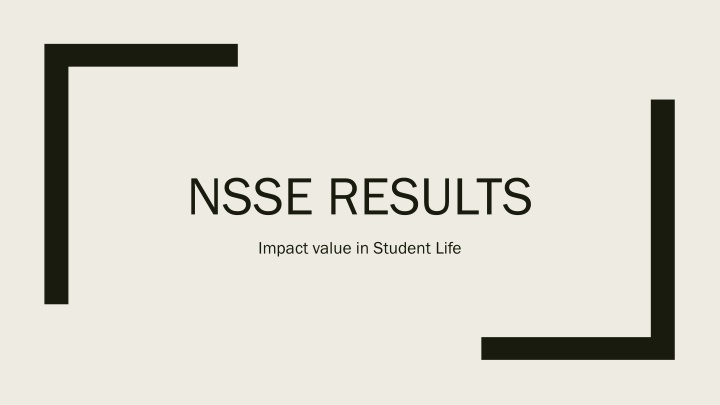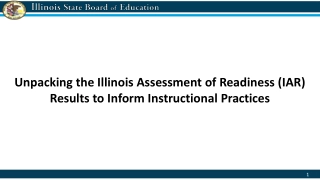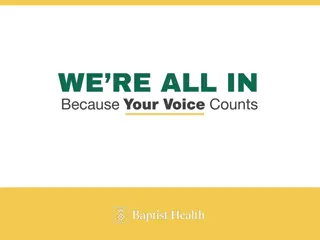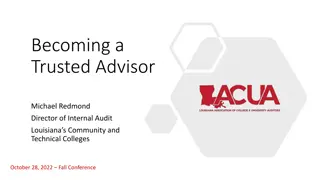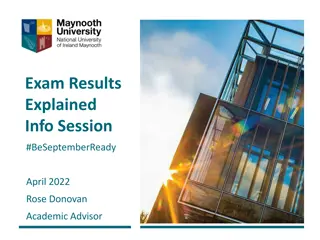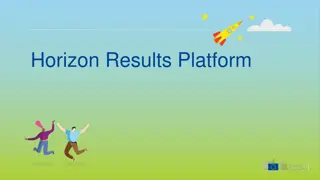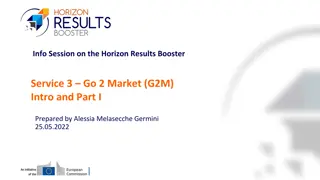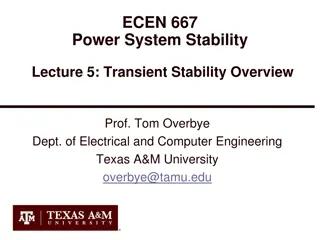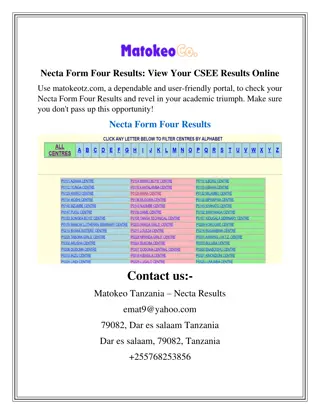NSSE RESULTS
The National Survey of Student Engagement (NSSE) collects data from colleges and universities to assess student engagement levels and improve educational practices. Student engagement involves time and energy devoted to studies and purposeful activities. Supporting literature highlights the importance of student engagement in improving undergraduate education quality.
Download Presentation

Please find below an Image/Link to download the presentation.
The content on the website is provided AS IS for your information and personal use only. It may not be sold, licensed, or shared on other websites without obtaining consent from the author.If you encounter any issues during the download, it is possible that the publisher has removed the file from their server.
You are allowed to download the files provided on this website for personal or commercial use, subject to the condition that they are used lawfully. All files are the property of their respective owners.
The content on the website is provided AS IS for your information and personal use only. It may not be sold, licensed, or shared on other websites without obtaining consent from the author.
E N D
Presentation Transcript
NSSE RESULTS Impact value in Student Life
What is NSSE- National Survey of Student Engagement NSSE annually collects information at hundreds of four-year colleges and universities about student participation in activities and programs that promote their learning and personal development. NSSE surveys first-year and senior students to assess their levels of engagement and related information about their experience at your institution. The results provide an estimate of how undergraduates spend their time. Institutions use their data to identify aspects of the undergraduate experience that can be improved through changes in policy and practice.
Goals of NSSE Project Focus conversations on undergraduate quality Enhance institutional practice and improvement initiatives Foster comparative and consortium activity Provide systematic national data on effective educational practices
What is student engagement? What students do Time and energy devoted to studies and other educationally purposeful activities What institutions do Using resources and effective educational practices to induce students to do the right things Educationally effective institutions channel student energy toward the right activities
Supporting Literature Traces the development of student engagement as a research-informed intervention to shift the discourse on quality in higher education to emphasize matters of teaching and learning while providing colleges and universities with diagnostic, actionable information that can inform improvement efforts. McCormick, A. C., Kinzie, J., & Gonyea, R. M. (2013). Student engagement: Bridging research and practice to improve the quality of undergraduate education. In M. B. Paulsen (Ed.), Higher education: Handbook of theory and research (pp 47-92), Vol. 28. Springer Netherlands. After a review of thousands of studies on college students from 1970 through the 1990s, Ernest Pascarella and Patrick Terenzini concluded student engagement is a central component of student learning. Pascarella, E. & Terenzini, P (2005). How college affects students: A third decade of research. San Francisco: Jossey-Bass Publishers. Presents institutional policies, programs, and practices that promote student success. Provides practical guidance on implementation of effective institutional practice in a variety of contexts. Kuh, G. D., Kinzie, J., Schuh, J. H., Whitt, E.J., & Associates (2005/2010). Student success in college: Creating conditions that matter. San Francisco: Jossey-Bass.
NSSE Survey Content Engagement in meaningful academic experiences Engagement in High-Impact Practices Student learning & development Student reactions to college Student background information
NSSE Engagement Indicators Engagement Indicators Engagement Themes Academic Challenge Learning with Peers Experiences with Faculty Student Faculty Interaction Campus Environment
What are HIPS? HIPS High Impact Best Practices (HIPs) share several traits: They demand considerable time and effort, facilitate learning outside of the classroom, require meaningful interactions with faculty and students, encourage collaboration with diverse others, and provide frequent and substantive feedback Kuh, G. D. (2008). High-impact educational practices: What they are, who has access to them, and why they matter. Washington, DC: Association of American Colleges and Universities.
Survey Administration Census-administered or randomly sampled first- year students & seniors Mobile-optimized survey Spring administration Multiple follow-ups to increase response rates Topical Modules provide option to delve deeper into the student experience Consortium participation enables addition of custom questions
Comparisons 1. Big 12 2. Carnegie Peers WVU specific survey Use of topical models 1. Academic Advising 2. Civic Engagement
Survey Participation 2019 Count 2019 (FY 908, 15%) (SR 628, 12%) 2013 2010 2007 2003 included the FSSE Response Rate is low : Big 12 and Carnegie comparison = (average for our size) 21% 21% Freshmen and 20% 20% Seniors
Demographics WVU Demographics 2019 Asian Black Hispanic Pacific Island 0.1% Two or more 3.8% 4.4% 4.4 % 4.2%
Overall Engagement highlights First Year Highest performing questions (Big 12) Lowest performing questions (Big 12) Spent more than 10 hrs per week on assigned reading (-6) Inst: Emphasized using learning support services (-6) Extent to which courses challenged you to do best (-7) Spent more than 15 hrs per week preparing for class (-7) Inst: Provided prompt and detailed feedback (-7) At least some courses included a community based practices (HIP) (+9) (+4 in 2013) Assigned more than 50 pages of writing (+7) Talked about career plans with faculty (+3) Inst: used examples or illustrations (+2) Worked with a faculty member or research (+1)
Overall Engagement highlights Senior Highest performing questions (Big 12) Lowest performing questions (Big 12) Completed a culminating senior experience (HIP) (+21) At least some courses included community-based practices (HIP)(+12) (not highest in 2013) Participated in an intern, co-op, field exp . (HIP) (+9) Worked with a faculty member or research (HIP) (+7) Inst. Providing support for your overall (+6) Examined the strengths and weaknesses of your own view (-5) Quality of interactions with Student service staff (-6) Participated in a study abroad (HIP) (-7) Spent more than 15 hrs per week preparing for class (-7) Spent more than 10 hours per week on assigned reading (-10)
HIPs First-Year
Student Engagement Components Time and effort students devote to activities shown in research to promote desired educational outcomes (Kuh, 2001, 2009) Includes two key components: Time and efforts devoted to effective educational practices Institutional resources and support to provide effective educational practices The second component represents an area where student life professionals can be particularly influential
Student Life can have an impact! At high-performing colleges and universities, student affairs (life) staff collaborate with others to periodically collect and review data about the effectiveness of policies and practices (Kuh, Kinzie, Schuh, Whitt & Associates, 2010) SL supports/or can support each area of HIPs and EIs NSSE results provide indicators of educational quality what matters to student success View student engagement results as an opportunity to collaborate with other units to address campus concerns
Example of Data Use: Supportive Environment and Retention CALIFORNIA STATE UNIVERSITY, SAN BERNADINO Finding: Campus living environment affects graduation and retention rates, as do student characteristics. Action: NSSE data used to determine which campus housing practices have the most impact on student learning and success. NSSE also gives insight into populations of students who face unique challenges that other surveys may not capture.
Example of Data Use: Foster Collaboration and Focus BIOLA UNIVERSITY Finding: Early results showed lower NSSE scores on an Engagement Indicator than desired. Action: Additional analyses were conducted and results disaggregated by student characteristics. Institution offered additional training on classroom behaviors.
Example of Data Use: Engaging Support Units California State University Finding: Learn that students spend more hours working for pay than do students at similar institutions. Action: Guide campus conversations on how to best support these students.
Example of Data Use: Enhance Diversity Initiatives Bucknell University Finding: Looked at responses by racial and ethnic group and compared HIPs and EIs. Action: Made significant changes to both Orientation Assistants and Resident Advisors to include new topics and offices focused on diversity and inclusion.
Questions of interest at WVU Are we meeting our expectations for a supportive campus environment? How frequently do our students interact with faculty outside of the classroom? Dos this match out claims? Are first-year students who withdraw from the institution different in terms of engagement than students who are retained? What impact does our learning communities have on participants? By demographics? To what extent are seniors experiencing an enriched education - do we pull programming through to senior year or focus predominately on first year?
IF YOU WOULD LIKE TO LOG IN AND VIEW ALL THE DATA, PLEASE EMAIL ME AND I WILL SET UP YOUR ACCOUNT. Thank you
